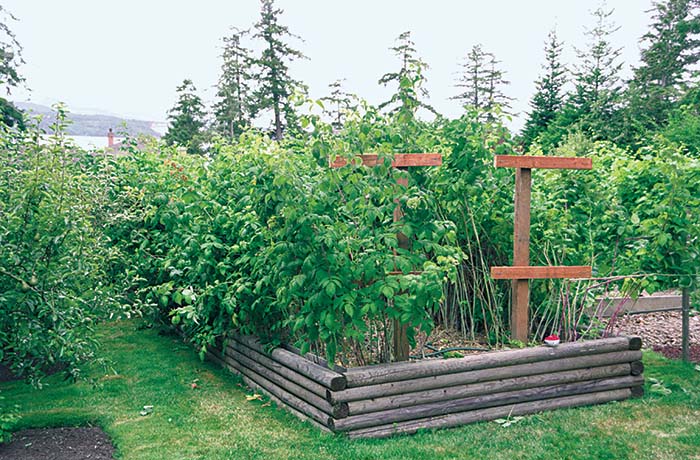How To Grow Raspberries In A Raised Bed For A
Raspberries are a delicious and versatile fruit that can be enjoyed fresh, frozen, or cooked. They are also a relatively easy fruit to grow, especially in a raised bed.
A raised bed is a great way to grow raspberries because it provides the perfect growing conditions for these plants. Raised beds are typically filled with a well-draining soil mix that is rich in organic matter. This type of soil is ideal for raspberries, which prefer a slightly acidic pH between 6.0 and 6.5.
In addition to providing good drainage, raised beds also make it easier to control pests and diseases. This is because the raised bed walls help to keep out pests and diseases that are common in garden soil.
If you are thinking about growing raspberries in a raised bed, here are some tips to help you get started:
- Choose the right location. Raspberries need full sun, so choose a spot in your garden that gets at least 6 hours of sunlight per day.
- Prepare the soil. The soil in your raised bed should be well-draining and rich in organic matter. If your soil is not already in good condition, you can amend it with compost or manure.
- Plant the raspberries. Raspberries are typically planted in the spring or fall. When planting, space the plants 18-24 inches apart.
- Water the raspberries regularly. Raspberries need about 1 inch of water per week.
- Fertilize the raspberries. Raspberries should be fertilized in the spring and fall. Use a fertilizer that is high in nitrogen and potassium.
- Prune the raspberries. Raspberries should be pruned in the winter. This will help to keep the plants healthy and productive.
With a little care and attention, you can enjoy a bumper crop of raspberries from your raised bed.
Here are some additional tips for growing raspberries in a raised bed:
- Use a trellis to support the raspberry canes. This will help to keep the plants upright and make it easier to pick the berries.
- Mulch the soil around the raspberry plants. This will help to keep the soil moist and suppress weeds.
- Protect the raspberries from pests and diseases. You can do this by using row covers or insecticidal soap.
- Harvest the raspberries when they are ripe. Raspberries are typically ripe when they are a deep red color.
Conclusion
Growing raspberries in a raised bed is a great way to enjoy this delicious and versatile fruit. With a little care and attention, you can have a bumper crop of raspberries every year.
Are you looking for more information about raspberry raised beds? Visit Garden Wiki for a comprehensive guide on how to build and maintain a raspberry raised bed. This guide includes everything you need to know, from choosing the right location and materials to planting and harvesting your raspberries.
FAQ of raspberry raised bed
What are the benefits of using a raised bed for raspberries?
Raised beds offer a number of benefits for growing raspberries, including:
- Improved drainage: Raspberries are susceptible to root rot, so raised beds help to ensure that the soil is well-drained.
- Reduced pest and disease pressure: Raised beds can help to protect raspberries from pests and diseases that are present in the soil.
- Easier access: Raised beds make it easier to reach the plants and harvest the fruit.
- Increased yields: Raised beds can help to increase raspberry yields.
How do I start a raspberry bed?
Here are the steps on how to start a raspberry bed:
- Choose a location that receives full sun.
- Prepare the soil by tilling it to a depth of 12 inches and adding compost or manure.
- Build the raised bed to a height of 12-18 inches.
- Plant the raspberries 3-4 feet apart.
- Water the raspberries regularly.
- Fertilize the raspberries in the spring and fall.
- Prune the raspberries in the winter.
What type of soil do raspberries need?
Raspberries need well-drained, loamy soil that is rich in organic matter. The soil pH should be between 5.5 and 6.5.
How much water do raspberries need?
Raspberries need to be watered regularly, especially during the hot summer months. The soil should be kept moist, but not soggy.
When should I plant raspberries?
Raspberries can be planted in the spring or fall. However, fall planting is preferred, as the plants will have time to establish themselves before the winter.
How do I trellis raspberries?
Raspberries can be trellised to help them grow upright and to make harvesting easier. There are a number of different ways to trellis raspberries, but the most common method is to use a wire trellis.
How do I prune raspberries?
Raspberries should be pruned in the winter to remove dead or diseased canes. Summer-bearing raspberries should also be pruned in the summer to remove the old canes that have fruited.
What are some common pests and diseases of raspberries?
Some common pests and diseases of raspberries include:
- Raspberry leafhopper
- Raspberry beetle
- Raspberry cane borer
- Powdery mildew
- Rust
How do I control pests and diseases of raspberries?
There are a number of ways to control pests and diseases of raspberries, including:
- Cultural controls: These include planting resistant varieties, rotating crops, and removing infected plants.
- Chemical controls: These should be used as a last resort, as they can be harmful to the environment.
Image of raspberry raised bed
- A raised bed filled with raspberry plants and a trellis for support.

- A close-up of raspberry plants growing in a raised bed.

- A raised bed with raspberry plants and a layer of mulch to help retain moisture.

- A raspberry raised bed built with cinder blocks.

- A raspberry raised bed with a wooden frame.

- A raspberry raised bed in a backyard garden.

- A raspberry raised bed in a community garden.

- A raspberry raised bed in a school garden.

- A raspberry raised bed in a greenhouse.

- A raspberry raised bed in a container.

Post a Comment for "How To Grow Raspberries In A Raised Bed For A"